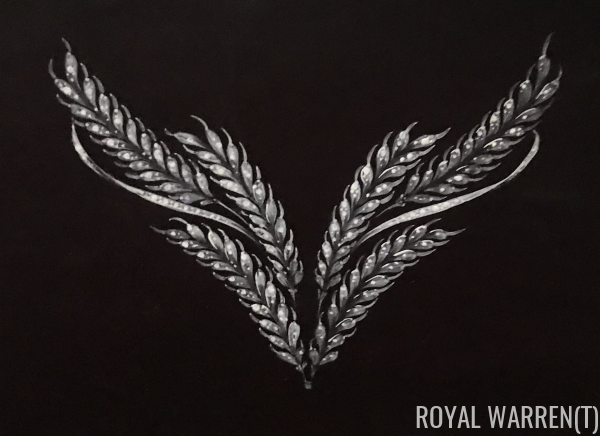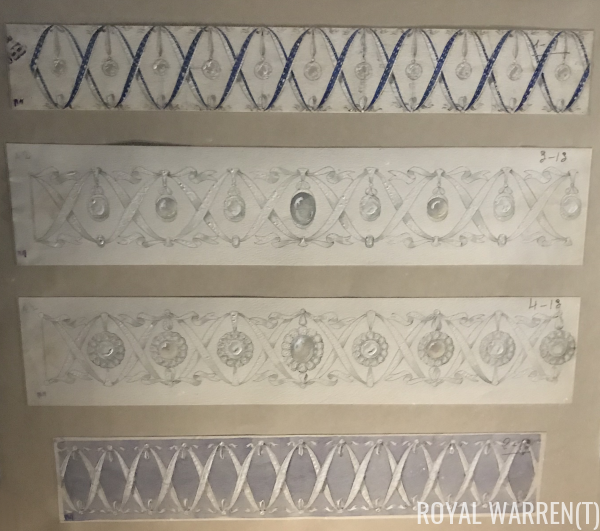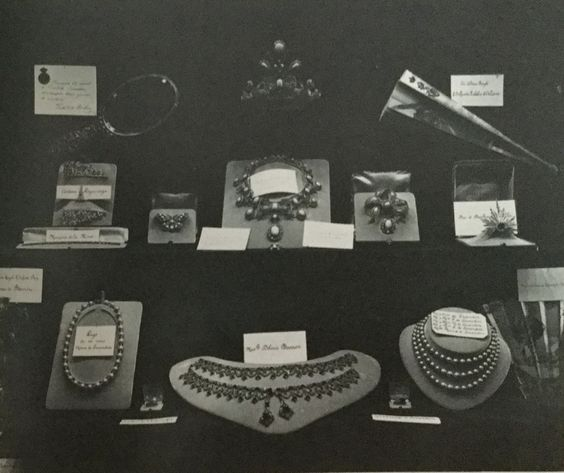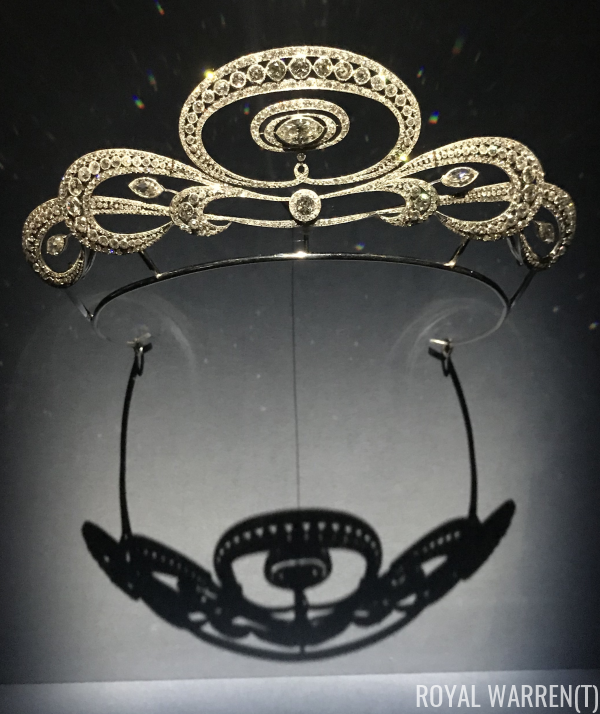 |
| United Archives/Alamy |
Chaumet in Majesty: Tiaras (and More!)
 |
| Photo generously provided by Royal Warren(t); do not reproduce |
Our journey through some of the jewels from the Chaumet in Majesty exhibition, which was recently mounted in Monaco, continues today with a tiara-focused look on the history of the jewelry firm. Thanks to lovely reader Royal Warren(t), we’re all able to enjoy some of the wonderful pieces shown in the exhibition!
 |
| Photo generously provided by Royal Warren(t); do not reproduce |
The jewelry firm that became the present-day House of Chaumet was founded in 1780 by Marie-Étienne Nitot. Before starting his own firm, Nitot had apprenticed with Marie Antoinette’s court jeweller, Aubert, and Nitot eventually made a name for himself when he was appointed court jeweler by Napoleon Bonaparte in 1802. (We discussed lots of Napoleonic-era pieces from the exhibition over here!) He was joined in the jewelry business by his son, François-Regnault Nitot; when the elder Nitot died in 1809, François-Regnault took over the business.
 |
| Photo generously provided by Royal Warren(t); do not reproduce |
One of the pieces that François-Regnault Nitot was involved with producing was this innovative wheat-ear jewel. The ears of wheat are made of diamonds set in gold, and they may have been produced as early as 1810. Today, they are mounted on a tiara frame.
 |
| Photo generously provided by Royal Warren(t); do not reproduce |
The notes from the Monaco exhibition explain that the jewel is known as the “Crèvecoeur,” a name which makes more sense when you see the ears of wheat arranged in their alternate form as a corsage ornament. In French, “crèvecoeur” means “broken heart,” and the shape of the ornament certainly reflects that sentiment.
 |
| Photo generously provided by Royal Warren(t); do not reproduce |
The exhibition also included the case for the tiara/corsage ornament, along with the alternate fitting and the tiny screwdrivers used to mount the jewels on the frames. The case is signed by Joseph Chaumet, who ended up at the head of the firm through a series of business partnerships and fractures. In 1815, at the end of Napoleon’s reign, François-Regnault Nitot went into exile, selling the family business to the firm’s master craftsman, Jean-Baptiste Fossin, and Fossin’s son, Jules. In the 1830s and 1840s, the firm prospered with a new head of the workshop, Jean-Valentin Morel, at the helm. Eventually, Morel helped the firm establish a new workshop in London, where he and his son Prosper Morel, produced jewelry for an elite clientele. In 1885, Prosper Morel’s daughter, Marie, married Joseph Chaumet — who then became head of the firm that now bears his name.
 |
| Photo generously provided by Royal Warren(t); do not reproduce |
Under the direction of Joseph Chaumet, the firm put down permanent roots in Paris. These drawings, which are designs for choker necklaces, date from 1891, near the beginning of Joseph Chaumet’s tenure as head of the house. (If you know your royal tiaras, these designs will look quite familiar to you!)
 |
| Photo generously provided by Royal Warren(t); do not reproduce |
The necklace designs reflect the prevailing jewelry tastes during the last decade of the nineteenth century and the first years of the twentieth century.
 |
| Photo generously provided by Royal Warren(t); do not reproduce |
In 1891, the firm was commissioned to make an impressive suite of jewels for the wedding basket of a Spanish noble client, Don Felipe Falco, the 8th Duke of Montellano. (What’s a wedding basket? Find out here!) Felipe was part of the royal household of King Alfonso XIII of Spain. The jewels needed to be impressive: Felipe’s bride-to-be, Carlota Maximiliana de Escandón y Barrón, was part of an exceptionally wealthy family; her father was Antonio de Escandón y Garmendia, a Mexican banker and railroad tycoon. He had been one of the group of conservative businessmen who had offered the Mexican throne to Emperor Maximilian I in 1859, and after the fall of Maximilian in the 1860s, Antonio and his family went into exile in Paris. Carlota Maximiliana was born in France in 1864, and you’ll note that she was named after both Emperor Maximilian and Empress Carlota. (More on them over here!)
 |
| Wedding gifts of the Duchess of Montellano |
Here’s a view of the display of Carlota’s wedding gifts from 1891. The original jewels from the Chaumet parure, which were made of gold, diamonds, and turquoises, are displayed near the center of the image. The tiara originally featured a jeweled plume, and the necklace has also been renovated over subsequent years.
 |
| Photo generously provided by Royal Warren(t); do not reproduce |
Here’s a closer view of the present-day tiara from the exhibition in Monaco…
 |
| Photo generously provided by Royal Warren(t); do not reproduce |
…as well as a view of the current iteration of the necklace, which was also on display in the Chaumet exhibition.
 |
| Grand Ladies Site |
The Duke and Duchess of Montellano were devoted royal courtiers after their marriage. Felipe continued to serve as one of the Gentilhombre Grandes de España, and Carlota later also became a lady-in-waiting to Queen Victoria Eugenie. They returned to Paris after the proclamation of the Second Republic in 1931; Felipe passed away there in the same year, and Carlota died in 1936.
 |
| Photo generously provided by Royal Warren(t); do not reproduce |
In 1907, Joseph Chaumet established a permanent home for the firm at 12 Place Vendôme in Paris. The following year, the workshop produced a lovely diamond scrollwork tiara for the Marquise de Talhouët. The tiara, made of gold and silver set with diamonds, now belongs to the Chaumet Collection.
 |
| Photo generously provided by Royal Warren(t); do not reproduce |
Also part of the Chaumet Collection is this pair of platinum, diamond, and enamel wings. The jewels were made in 1910 and mounted on a tiara for a prominent American heiress and artist.
 |
| Wikimedia Commons |
The diamond wings were perfectly suited for Gertrude Vanderbilt Whitney, who was a sculptor and artist in her own right, as well as a member of two of the wealthiest families in America, the Vanderbilts and the Whitneys. In the first decade of the twentieth century, she set up a studio in a fashionable part of Paris, and by 1910, the year that the diamond wings were made, she started exhibiting her own work.
 |
| Photo generously provided by Royal Warren(t); do not reproduce |
In 1910, the firm also made this unusual sparkler out of platinum and diamonds.
 |
| Photo generously provided by Royal Warren(t); do not reproduce |
The exhibition notes described the piece as a “rounded palms tiara,” on loan from the Qatar Museums.
 |
| Photo generously provided by Royal Warren(t); do not reproduce |
The firm produced this shell corsage ornament in 1913. The jewel features a 322-carat aquamarine set in a frame of gold, silver, and diamonds. Gemstone drops mimic water droplets on the ornament’s pendants.
 |
| Photo generously provided by Royal Warren(t); do not reproduce |
Another major commission came in 1919, just after the end of World War I. Armand de la Rochefoucauld, Duke of Doudeauville asked Chaumet to make a tiara for his daughter, Hedwige, who was engaged to marry Prince Sixtus of Bourbon-Parma. The tiara the atelier produced is remarkable: a delicate diamond tiara of open-petaled fuschias. The exhibition notes explain that “nine drop-shaped finials” sit atop the tiara. Those finials were made using a common Chaumet technique, tromp l’oeil, which “sought to create the illusion of a single stone by gathering several diamonds in a discreet pear-shaped mount.” Today, the tiara has returned to the Chaumet Collection.
 |
| Photo generously provided by Royal Warren(t); do not reproduce |
The Chaumet Collection also includes this diamond, gold, and platinum tiara with a delicate foliage design, made by the firm around 1920.
 |
| Photo generously provided by Royal Warren(t); do not reproduce |
Joseph Chaumet died in 1928, and the firm was passed to his son, Marcel. Under Marcel Chaumet’s tenure, the firm focused heavily on the art deco styles popular during the period. This sautoir was made by the workshop in 1929 with palladium-plated gold, rock crystal, and diamonds.
 |
| Photo generously provided by Royal Warren(t); do not reproduce |
And finally, our journey through the exhibition jewels concludes with this convertible diamond and ruby tiara, made by Chaumet in 1937. It was part of a parure of diamond and ruby jewelry made for Infante Alfonso, Duke of Calabria. The suite was commissioned a year after his wedding to Princess Alicia of Bourbon-Parma, using rubies he had inherited from his grandmother, Queen Maria Cristina of Spain. The tiara was inherited by Alfonso and Alicia’s daughter, Princess Teresa Maria, who married the 12th Marquess of Laula. She subsequently sold the tiara, and according to the notes from this exhibition, the jewel now resides in Taipei as part of the Lin Family Collection.
The Daily Diadem: The Akishino Tiara
 |
| Carlos Bergamín/Alamy |
- « Previous Page
- 1
- …
- 500
- 501
- 502
- 503
- 504
- …
- 1917
- Next Page »